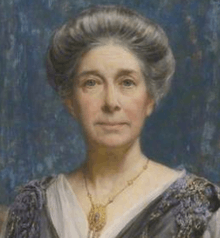Catherine Osler
Catherine Osler or Catherine Courtauld Osler; Catherine Courtauld Taylor (26 February 1854 – 16 December 1924) was a British social reformer and suffragist.
Catherine Osler | |
|---|---|
 crop of Edward S. Harper portrait | |
| Born | Catherine Courtauld Taylor 26 February 1854 Bridgwater, England |
| Died | 16 December 1924 (aged 70) Edgbaston, England |
| Nationality | British |
| Spouse(s) | Alfred Ostler |
Biography
Osler was born in Bridgwater in 1854 to William and Catherine Taylor.[1] Her Unitarian parents were members of the Birmingham Women's Suffrage Society from its formation. Catherine was their eldest child and she rose through the ranks of the society as she went from treasurer to secretary in 1885.[2]
She married Alfred Osler who ran the family firm of F & C Osler of Birmingham, a firm famous for the design and manufacture of fine crystal, exemplified by magnificent pieces such as chandeliers to be found in grand buildings in many parts of the world. Alfred Osler was a member of the Liberals. In 1888 the Women's Liberal Federation had a conference in Birmingham and Catherine Osler was asked to preside over it.[3] Four years later the Women's Emancipation Union met in Birmingham and Osler was invited to chair a session where she shared her ambition to get women involved in local government.[4]
In 1903, she became the President of the Birmingham Women's Suffrage Society.[2]
Osler was opposed to the actions of the militant suffragettes and she had written to criticise the actions of the Women's Social and Political Union. However she did not approve of the way the WSPU militants were treated in prison.[3] In 1909, she resigned as President of the Birmingham Women's Liberal Association citing her objection to the Liberal government's policy of force feeding suffragette prisoners.[2]
In 1911, Osler joined the executive committee of the National Union of Women's Suffrage Societies (NUWSS).[1] Osler was also active in Birmingham trying to establish a role for women in local government.[1]
In 1919, Osler was given a master's degree by Birmingham University for her work in support of the social standing of her gender. Osler died in Edgbaston in 1924. A portrait of her by local artist Edward Harper was commissioned and is now in a local gallery.[1]
Her name and picture (and those of 58 other women's suffrage supporters) are on the plinth of the statue of Millicent Fawcett in Parliament Square, London, unveiled in 2018.[5][6][7]
Works
- Why Women Need the Vote, 1910
References
- Elizabeth Crawford, ‘Osler , Catherine Courtauld (1854–1924)’, Oxford Dictionary of National Biography, Oxford University Press, Sept 2013 accessed 20 November 2017
- "Catherine Osler | Great British - bringing you closer to our history makers". great-british.co.uk. Retrieved 20 November 2017.
- "Catherine Osler". Spartacus Educational. Retrieved 20 November 2017.
- "Suffrage Stories: 'From Frederick Street to Winson Green': The Birmingham Women's Suffrage Campaign". Woman and her Sphere. 22 March 2013. Retrieved 20 November 2017.
- "Historic statue of suffragist leader Millicent Fawcett unveiled in Parliament Square". Gov.uk. 24 April 2018. Retrieved 24 April 2018.
- Topping, Alexandra (24 April 2018). "First statue of a woman in Parliament Square unveiled". The Guardian. Retrieved 24 April 2018.
- "Millicent Fawcett statue unveiling: the women and men whose names will be on the plinth". iNews. Retrieved 25 April 2018.